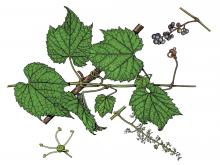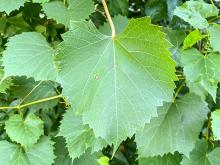Trees, Shrubs and Woody Vines
Media

Species Types
Scientific Name
Vitis cinerea
Description
Winter grape is a wild grapevine that can climb up to 50 feet. It occurs in low woods and along streams, in thickets, and in fencerows. It’s common in the southern two-thirds of Missouri.
Media

Species Types
Scientific Name
Vitis vulpina
Description
Frost grape is a vigorous vine climbing to 60 feet in length using tendrils. It is scattered statewide, growing in bottomlands, along streams, in low, wet woods, at bases of bluffs, and in thickets.
Media

Species Types
Scientific Name
Vitis riparia
Description
Riverbank grape is a woody wild grape vine climbing to 75 feet by means of tendrils. It occurs nearly statewide but is absent from most of the Ozark plateau.
Media

Species Types
Scientific Name
Vitis species
Description
Eight species of grapes in the genus Vitis are native or naturalized in Missouri. All bear edible fruits. Like their relatives elsewhere, they have important connections to humans and to nature.
Media

Species Types
Scientific Name
Rosa setigera
Description
Also called climbing rose, prairie rose is most common near woodlands, where it climbs and trails on neighboring shrubs and small trees.
Media

Species Types
Scientific Name
Carya spp.
Description
Hickories are an important part of Missouri’s oak-hickory woodlands and forests. They have tremendous economic value, too. Learn about the nine species of hickory found in Missouri.
Media

Species Types
Scientific Name
Quercus spp.
Description
Oaks are the most important group of trees in Missouri, in both human and ecosystem value. They dominate most of the forests, woodlands, and savannas in the state. Learn more about our 22 species.
Media

Species Types
Scientific Name
Vaccinium arboreum
Description
Farkleberry, or sparkleberry, is a stiff-branched shrub or small crooked tree growing in loose thickets on rocky soils, mostly south of the Missouri River. A type of blueberry, its black fruits are edible but dry and mealy.
Media

Species Types
Scientific Name
Ulmus spp.
Description
Missouri has seven species of elms that grow in natural settings. Elms have tough, shock-resistant wood. In the past, some species were favorite shade trees, which is why so many towns have Elm Streets. But elms have suffered for a century from a devastating fungal disease.
Media

Species Types
Scientific Name
Nyssa aquatica
Description
Water tupelo, or tupelo gum, is a large tree with a large, swollen, sometimes buttressed base, a tapering trunk, and a flattened, spreading crown. It and bald cypress are the dominant trees in Missouri’s Bootheel swamps.
See Also
About Trees, Shrubs and Woody Vines in Missouri
There are no sharp dividing lines between trees, shrubs, and woody vines, or even between woody and nonwoody plants. “Wood” is a type of tissue made of cellulose and lignin that many plants develop as they mature — whether they are “woody” or not. Trees are woody plants over 13 feet tall with a single trunk. Shrubs are less than 13 feet tall, with multiple stems. Vines require support or else sprawl over the ground.





















